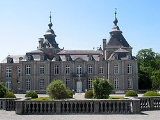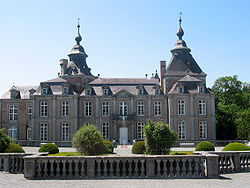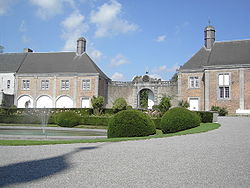
Castle of Modave
Encyclopedia



Château
A château is a manor house or residence of the lord of the manor or a country house of nobility or gentry, with or without fortifications, originally—and still most frequently—in French-speaking regions...
near the village of Modave
Modave
Modave is a municipality of Belgium. It lies in the country's Walloon Region and Province of Liege. On January 1, 2006, Modave had a total population of 3,722. The total area is 40.37 km² which gives a population density of 92 inhabitants per km². The magnificent "Château des Comtes de Marchin" or...
in the province of Liège, Belgium
Belgium
Belgium , officially the Kingdom of Belgium, is a federal state in Western Europe. It is a founding member of the European Union and hosts the EU's headquarters, and those of several other major international organisations such as NATO.Belgium is also a member of, or affiliated to, many...
.
History
The oldest part of the building, the donjon, was built on a strategic rock high above the valley of the river HoyouxHoyoux
The Hoyoux is a river of Belgium, a right tributary of the Meuse. It flows for 28 kilometres through the province of Liège in the northern-central part of the country. It flows into the Meuse in Huy....
. The oldest parts still visible today date probably from the 13th century and were erected by the lords of Modave. In the 16th century the castle and the estate of Modave became the property of the Haultepenne and de Saint-Fontaine families.
In the next century Jean-Gaspard-Ferdinand de Marchin
John Gaspar Ferdinand de Marchin, Comte de Granville
John Gaspar Ferdinand de Marchin, or Marsin, Comte de Granville was a Walloon military commander from the Spanish Netherlands.-Life:...
(1601-1673), a great military commander, acquired the castle and turned it from a medieval fortress into a luxury Baroque
Baroque architecture
Baroque architecture is a term used to describe the building style of the Baroque era, begun in late sixteenth century Italy, that took the Roman vocabulary of Renaissance architecture and used it in a new rhetorical and theatrical fashion, often to express the triumph of the Catholic Church and...
residence. His son Ferdinand de Marsin
Ferdinand de Marsin
Ferdinand, comte de Marsin was a French general and diplomat, who was Marshal of France.-Biography:...
neglected the property and lived in France.
Later owners were successively:
- Maximilian Henry of BavariaMaximilian Henry of Bavariathumb|154 px|Maximilian Heinrich of BavariaMaximilian Henry of Bavaria was the third son and fourth child of Albert VI, landgrave of Leuchtenberg and his wife, Mechthilde von Leuchtenberg. In 1650, he was named Archbishop of Cologne, Bishop of Hildesheim and Bishop of Liège succeeding his uncle,...
, Elector of Cologne and rince-Bishop of LiègeLiègeLiège is a major city and municipality of Belgium located in the province of Liège, of which it is the economic capital, in Wallonia, the French-speaking region of Belgium....
(1682 - 1684); - Cardinal William Egon of FurstenbergWilliam Egon of FürstenbergWilliam Egon of Fürstenberg was a German clergyman who was bishop of Strasbourg.He began his career as a soldier in the French service....
, and his heirs (1684 - 1706); - Baron Arnold de Ville (1706 - 1772); and
- Anne-Léon, Duke of MontmorencyDuke of MontmorencyThe title of Duke of Montmorency was created several times for members of the Montmorency family, who were lords of Montmorency, near Paris.The first creation was in 1551 for Anne of Montmorency, Constable of France...
, and his heirs (1772 - 1817).
In the 19th century it was owned by the non-noble families of Lamarche, Braconier and Van Hoegaerden. Finally, the Compagnie Intercommunale Bruxelloise des Eaux ("Brussels Intercommunal Water Company") bought the property in March 1941, in order to protect the important water catchments in the park. The company still owns the château today and has been restoring it with great care. It is open for visitors from April until October and it is also used as a prestigious venue for concerts and receptions.
Architecture
The ancient fortified castle was rebuilt from 1659 to 1667 in a manner showing a remarkable affinity to the most modern ideas of European country house building of the time. It is particularly close to the buildings of François MansartFrançois Mansart
François Mansart was a French architect credited with introducing classicism into Baroque architecture of France...
. The dignified symmetry with a triangular pediment
Pediment
A pediment is a classical architectural element consisting of the triangular section found above the horizontal structure , typically supported by columns. The gable end of the pediment is surrounded by the cornice moulding...
accenting the main frontage, the geometrical articulation of the wall, the mansard roof
Mansard roof
A mansard or mansard roof is a four-sided gambrel-style hip roof characterized by two slopes on each of its sides with the lower slope at a steeper angle than the upper that is punctured by dormer windows. The roof creates an additional floor of habitable space, such as a garret...
s, and the spatial contrast between the corps de logis
Corps de logis
Corps de logis is the architectural term which refers to the principal block of a large, usually classical, mansion or palace. It contains the principal rooms, state apartments and an entry. The grandest and finest rooms are often on the first floor above the ground level: this floor is the...
and the side wings have much in common with Mansart's country houses, such as the Château de Maisons
Château de Maisons
The Château de Maisons , designed by François Mansart from 1630 to 1651, is a prime example of French baroque architecture and a reference point in the history of French architecture...
-Laffitte. Modave is the most prominent preserved example of High Baroque country-house architecture in the Southern Netherlands and the Prince-Bishopric of Liège.
The château is unique for its splendidly preserved historic interiors and furniture dating from the 17th and 18th centuries.
The stucco
Stucco
Stucco or render is a material made of an aggregate, a binder, and water. Stucco is applied wet and hardens to a very dense solid. It is used as decorative coating for walls and ceilings and as a sculptural and artistic material in architecture...
ceilings date from the second half of the 17th century and were created by Jan-Christian Hansche
Jan-Christian Hansche
Jan-Christian Hansche or Hanssche was a Flemish artist., possibly of German origin, who worked as a stuccoist in the Southern Netherlands, and also in Germany and Holland, in the second half of the 17th century....
.

